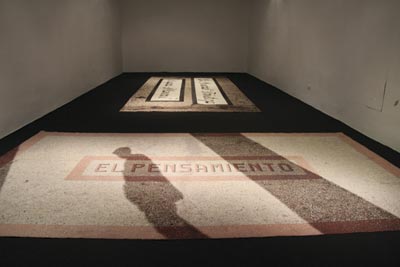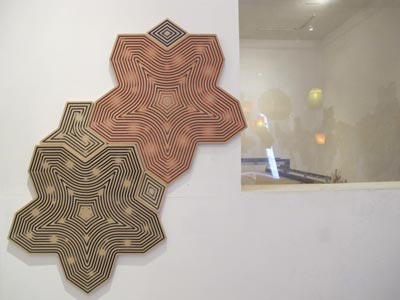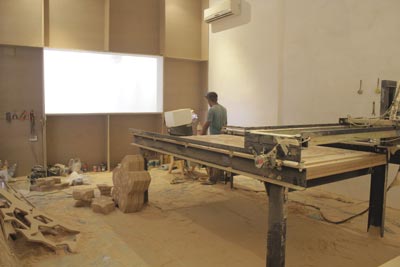A few years ago, Nelson Herrera Ysla called the Havana Biennale “the greatest gallery in the world”, and he was partly right. Like other capitals in the planet, up to a point, the Cuban one is a museum in itself, that of the first coloniality, of the revolutionary tropical modernism, the nostalgia and the ruin. In fact, every biennial is anchored in what the city’s ethos can grant it, and Havana certainly has a very powerful one.
The 11th Havana Biennale (May-June 2012) was summoned on the assumption of artistic practices and social imaginaries in search of a place in the circuit of “socially engaged art”, very in vogue after the debates about altermodern and relational art. There is nothing new in this approach regarding our cultural territory, and it is not alien either to the Biennale: we have seen it in previous editions, El arte con la vida 2003 (Art with Life), and Dinámicas de la cultura urbana 2006 (Dynamics of Urban Culture). Historically, many artists from the so-called “Global South” have taken on a social commitment and have explored this possibility in expanded terrains of artistic practices. In Latin America, from Mexican Muralism to New Cinema, going through Peruvian indigenismo, Brazilian Neo-Concretism, etc., have all accounted for this; a dimension of testimony and collective participation in public space takes part in the “should be” of this art.
In the Havana Biennale though, it is the city and its people that steal the show. The event, with its multiple and fragmented official program and the so-called collateral program (almost impossible to follow even for Biennale veterans), does not turn the city into a gallery but rather into a laboratory. And it is there where a point of inflection exists. A laboratory is the place for what is possible, and in many cases, it is also the place for failure. It is that space of what is viable that makes many of us travel to Havana to become immersed in discussions about the transforming potential of culture and art in society, located in a space ruled by revolutionary ideas that use what is institutional and political in a flexible way, giving new meaning to the question about the social imaginary.
 What is, then, a social imaginary? It is the set of suppositions about meanings and social relations, what we have to imagine with the aim of “consummating” –totally or partially– the society we belong to. They are, all in all, the symbols, the illusions created and kept by a society so people behave according to some “value systems”. Those systems reward the individual (capitalism case: work = profit = consumption) and correspond to their “idea” of happiness. The problem is that in urban spaces, highly connected (including Havana) by new technologies and mass media, those imaginaries tend to show the surface. If we count on artistic reflections and their (multiple and diverse) practices lying in particular socio-cultural contexts where “what is social” is pertinent, every artistic action would thus respond to the hegemonic social imaginary set. Why not talk about imaginaries that are not subject to the value systems of modernity/coloniality, imaginaries that make “another” society possible –that of respect for the environment, diversity, what is rural, the past, etc.? Of course, the modern phantom shelters us, and our thirst of being part of its project dazzles us[i].
What is, then, a social imaginary? It is the set of suppositions about meanings and social relations, what we have to imagine with the aim of “consummating” –totally or partially– the society we belong to. They are, all in all, the symbols, the illusions created and kept by a society so people behave according to some “value systems”. Those systems reward the individual (capitalism case: work = profit = consumption) and correspond to their “idea” of happiness. The problem is that in urban spaces, highly connected (including Havana) by new technologies and mass media, those imaginaries tend to show the surface. If we count on artistic reflections and their (multiple and diverse) practices lying in particular socio-cultural contexts where “what is social” is pertinent, every artistic action would thus respond to the hegemonic social imaginary set. Why not talk about imaginaries that are not subject to the value systems of modernity/coloniality, imaginaries that make “another” society possible –that of respect for the environment, diversity, what is rural, the past, etc.? Of course, the modern phantom shelters us, and our thirst of being part of its project dazzles us[i].
A positive aspect is that the Havana Biennale manages to force the visitor and the guest artist to come out of their comfort space –that of the art-institution, museum and gallery–, and go into action by bringing them face to face with the city and its contexts. This is one of the historic contributions of the event, and it takes part in a policy linked to the distribution of the benefits of cultural tourism to multiple sectors of the population that operate today under an economic opening, creating a gradual service offer. Additionally, this is an exercise in discipline for the visitor at the Biennale. Nevertheless, it was an unfortunate decision to dismantle some of the few events that kept cohesion in the middle of fragmentation, such as, the Forum-Idea at the National Museum of Fine Arts or the spaces at Morro-Cabaña. These were meeting points around ideas, pieces and artists.[ii]
 Initiatives like Detrás del muro (Behind the Wall), though outstanding for putting in touch artists and audience, ended up as a minuscule gesture (when intending to be a spectacle) against the backdrop provided by the Havana seafront. This is due to the “projecting” and not the “processual” character of the selected pieces. Taking into consideration the urban space per se does not account for its social dynamic, in general the pieces seemed to fall from another planet. With some exceptions, as it is the case of Pureza (Purity) by Aimeé García (stemmed from the conceptual work by Colombian María Angélica Medina, presented at the 1997 Biennale), which invited the audience to sit down on a delicate fabric in the making, while interacting with the women weavers. Likewise, Poema para un agujero negro (Poem to a Black Hole) by Fidel Alvarez involved some local fishermen who threw black balloons with starfish in the air. And among the most ambitious ones Realidad (Reality)/ Happily Ever After by Rachel Valdés, a big-sized mirror, similar in shape and color to the famous anti-monument Vietnam Wall (by Maya Lin) in Washington DC, that reflected the ocean horizon and the passersby, allowing to see those who are no longer here nor there…
Initiatives like Detrás del muro (Behind the Wall), though outstanding for putting in touch artists and audience, ended up as a minuscule gesture (when intending to be a spectacle) against the backdrop provided by the Havana seafront. This is due to the “projecting” and not the “processual” character of the selected pieces. Taking into consideration the urban space per se does not account for its social dynamic, in general the pieces seemed to fall from another planet. With some exceptions, as it is the case of Pureza (Purity) by Aimeé García (stemmed from the conceptual work by Colombian María Angélica Medina, presented at the 1997 Biennale), which invited the audience to sit down on a delicate fabric in the making, while interacting with the women weavers. Likewise, Poema para un agujero negro (Poem to a Black Hole) by Fidel Alvarez involved some local fishermen who threw black balloons with starfish in the air. And among the most ambitious ones Realidad (Reality)/ Happily Ever After by Rachel Valdés, a big-sized mirror, similar in shape and color to the famous anti-monument Vietnam Wall (by Maya Lin) in Washington DC, that reflected the ocean horizon and the passersby, allowing to see those who are no longer here nor there…
MAC/SAN, Museum of Contemporary Art in San Agustín, due to its line of reflection, its production and carrying out, was undoubtedly one of the most outstanding projects in the event. Its location in San Agustín, a residential complex developed early in the seventies that architecturally followed Soviet modular rules, scrutinized one of those spaces for the construction of the revolutionary project (we had already seen some projects developed from Alamar in previous years). After five decades, the district maintains a certain dignity, while the people from San Agustín are still reluctant to live in proto-modernist white cubes. MAC/SAN, dedicated to contemporary artistic practices in the public domain, invited an outstanding group of local and international participants to interact under several premises: art, territory, heritage, town planning-environment and pluriformism. The collective uses LASA –Laboratorio Artístico de San Agustín (Artistic Lab in San Agustin)– as a platform, which has been working in the neighborhood since 2008, generating a series of residences that stimulate dialogue about art, aesthetics and art policy. Hence, the project answered to an expanded process, where the Biennale turns out to be just a particular instant in a series of other moments. There is the key.
 This short reflection would not be complete without mentioning some other notable individuals and projects with respect to the ideas displayed at the Biennale. The solo show by Carlos Garaicoa, Fin del Silencio (End of Silence) –which like Goya leaves a legacy in the form of a tapestry, where the main protagonist is again the city of Havana–, enlightened us about the creative capacity of one of the most important contemporary Cuban artists. The project Ciudad generosa (Generous City) by twelve third-year students from the Instituto Superior de Arte, ISA (Fourth Pragmatics) and René Francisco, emphasized again the interest in stressing public spaces, opening possibilities of participation and production capacity beyond the art space and the Biennale moment. We also celebrate the partaking of the groupCaja Lúdica (Guatemala), as well as the work in public spaces -impossible to conceive in the near past– by the post-graffiti artist and French activist JR, who reminded us we cannot relegate “our elderly” in this frantic search for the new. Equally, we praise the opportunity of visiting the ruin after the trigger of sense produced during the workshop organized by Gabriel Orozco at ISA.
This short reflection would not be complete without mentioning some other notable individuals and projects with respect to the ideas displayed at the Biennale. The solo show by Carlos Garaicoa, Fin del Silencio (End of Silence) –which like Goya leaves a legacy in the form of a tapestry, where the main protagonist is again the city of Havana–, enlightened us about the creative capacity of one of the most important contemporary Cuban artists. The project Ciudad generosa (Generous City) by twelve third-year students from the Instituto Superior de Arte, ISA (Fourth Pragmatics) and René Francisco, emphasized again the interest in stressing public spaces, opening possibilities of participation and production capacity beyond the art space and the Biennale moment. We also celebrate the partaking of the groupCaja Lúdica (Guatemala), as well as the work in public spaces -impossible to conceive in the near past– by the post-graffiti artist and French activist JR, who reminded us we cannot relegate “our elderly” in this frantic search for the new. Equally, we praise the opportunity of visiting the ruin after the trigger of sense produced during the workshop organized by Gabriel Orozco at ISA.
Other spaces like the exhibition La caza del éxito (Success Hunt), besides being fun and fresh, gave evidence that processes of self-management/self-construction and long-lasting aesthetic ideals (Disneylike Greco-Roman ones, which are also the modern/colonial type) are not exclusive of outlying cities, and that Havana takes also part in the same network. We found a good balance between space and content in the show Creaciones compartidas (Shared Creations) at Pabellón Cuba, and a tight group of pieces in Open Score. Initiatives like Paladar where much more important than others arrived from the northern country.
Unfortunate and overproduced was the presence of Austrian Hermann Nitsch (who did not only bring a bad taste of the nostalgia of the sixties and seventies, but also an exacerbated and Eurocentric perspective about it). Unfortunate the museography at Gran Teatro de La Habana, a beautiful place massacred by an exhibition that did not manage to overcome its own carrying out and content. And very unfortunate the repeated apologies for not having resources to do better, since the Biennale counts with an extraordinary backing on the part of guest participants and artists, a staff of professionals with great management skills, volunteers, local institutions (complete support from the National Council of Plastic Arts and the Ministry of Culture) and friendly international institutions, etc., impossible in any other place on the planet.
Finally, we are pleased with the fact the Biennale invited important “non-insular” Cuban names: Jorge Pardo, María Magdalena Campos, Tony Labat, Raúl Ferrera, among others, acknowledging they have an active part in the Cuban artistic scene. The presence of the Kabakov artists and Boris Groys (with a text in the catalogue) was also disquieting. The opening brings with it opportunities and challenges. It is worth noting the media coverage in Cuban television, as well as through some Cuban cultural news portals and blogs, whereas an almost total absence of the international cultural press was surprising, except for the New York Times, that highlights the “American return” to the Biennale after the Bush era, market power and all.[iii]
 Conclusion
Conclusion
Can the Biennale constitute an experimental and participatory platform sustained in time? Is the Centre Wilfredo Lam the institution destined to do it? Can it publicly project, using its support network, a new course, and thus build a sustainable future? That way, what is processual in the practices would be constituted in the matrix of an event that capitalizes on the energy of the art and cultural world in Cuba –counting with the institutional and political will to use culture and arts as part of the national project. For this purpose, a logistic and production change is necessary, establishing a post-document or a series of documents that account for the scope of an event that tends to fragmentation, not as an option, but as an answer to the overflow of artistic and cultural practices and their emancipation from the institutions and the market. An inevitable answer to the expanded space of production, participation and circulation of the arts and culture today.
[i] What is problematic, in fact, is to bring up names like Charles Taylor or Homi Bhabha (Francisco Jarauta even) as conceptual supports of the project, these (although progressive thinkers) only give the Biennale an Eurocentric-modernist sense, which we thought the Biennale had freed itself from in the past; fortunately, the text by Dannys Montes de Oca seems to have this discourse inconsistency clear.
[ii]This generated disorganization, beyond the usual at the Biennale. Although the intention was to expand its reach, it made captive audiences disperse. We celebrate, no doubt, the commitment and participation in the theoretical event of the Centro Teórico-Cultural Criterios and its director Desiderio Navarro. This kind of collaborations becomes more and more important due to the nature of the cultural, academic and artistic projects. We also acknowledge the true “Biennale”, in the strict sense, was found at Morro, a space for promotion and market of the country’s visual production. The world of Cuban art is highly professionalized today, establishing a number of agents that work as mediators between producers and institutions (foundations, collectors, galleries, museums, etc.). It is clear how the artist’s and cultural worker’s status in Cuba is acknowledged, and takes part in a cultural policy that does not only intend to promote creation, but also to establish a space of economic development.
[iii] VICTORIA BURNETT, “American Accents Being Heard on the Malecón”. From: The New York Times, Art & Design, May 18th, 2012










